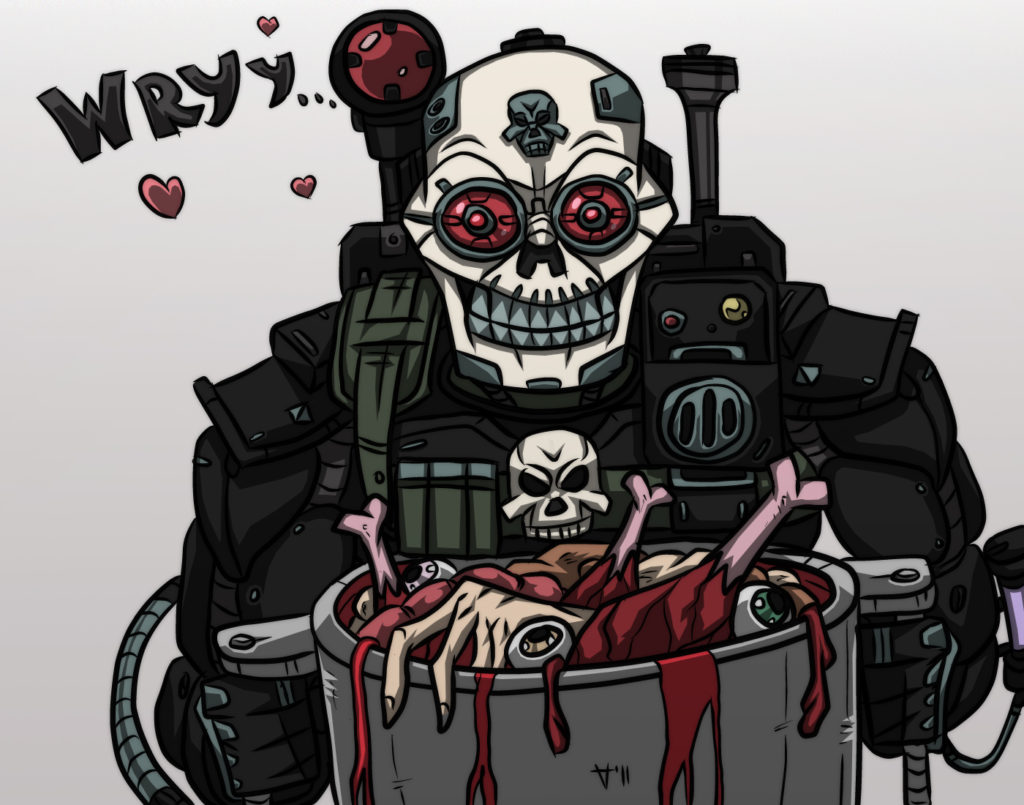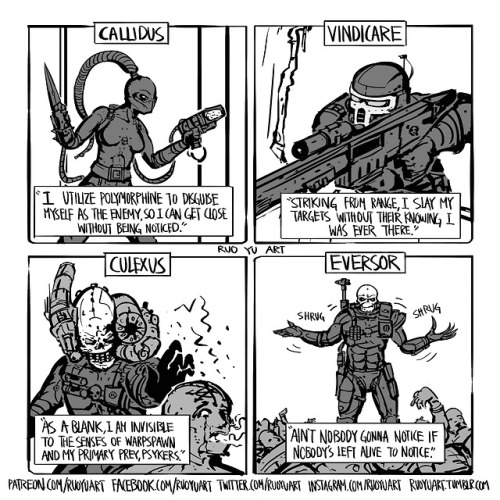He’s mad as hell, and he is not going to take it anymore. Click to read on, or check out the Tactics Corner for more reviews and strategies.
Welcome to the first article in my review series on Assassins! With the updates to their datasheets and addition of unique stratagems for the faction, they have become a much more popular option- however, I think a lot of people are misunderstanding what the assassins are actually good at. In this series, I’ll look at each of the four assassins and their strengths as well as weaknesses to try and get a better picture of how they should be used or included in an army. Since the assassins aren’t part of a “proper” codex yet, I will also be adding a new section to cover the stratagems that each assassin can use (though the rest of the review will otherwise follow the usual format.)
One very important thing to remember is that all four assassins can be brought into any Imperial army that has 85pts and 1CP laying around at the beginning of the game; this, for the first time, allows a nontrivial amount of customization on a game-to-game basis for Imperial players in a way that has not been possible before and is somewhat reminiscent of summoning or other, similar mechanics. With this option potentially available to many armies, one should always keep in mind that it is possible to have this “toolbox” around to draw on- though whether or not it will be popular enough to be consistently included in lists depends on a lot of factors in the meta. I won’t pretend to be able to predict that, but it is certainly a possibility you should think about.
Overview
The Eversor Assassin is… a misunderstanding of what an “assassin” is. The Eversor Temple’s modus operandi is to sow terror and wholesale destruction through the rampaging of an unstoppable destructive force in the enemy’s ranks. Guys… that’s not assassination, that’s war. That is just war. However, with the Imperium being about as dumb as a sack of bricks held in the servo-arm of a robotic baby skull, we can forgive them for this, because the Eversor is a pretty rad dude.
Like all assassins, the Eversor comes with a very nice statline- movement 7″ makes it a bit quicker on the ground than most things and weapon skill/ballistic skill 2+ mean that it will generally hit what it goes after, bar some exceptional modifiers. Strength and toughness four are merely average, but combined with six wounds and six attacks that gives it a very solid presence on the board that can’t be ignored. Leadership nine and armor 6+ should both be all but irrelevant during the game, unless some wacky psychic powers get cast. At a mere 85pts, the Eversor is a really solid deal, especially since it comes with the character keyword, preventing it from being targeted.
Wargear and Special Rules
Like all assassins, the Eversor comes with a set of special common special rules as well as quite a list that are unique to it. Execution Force allows you to field it in an army, and little else. Independent Operative means it can never be your warlord and is allowed to deploy into reserves (arriving in the usual fashion more than 9″ from the enemy.) Lightning Reflexes gives it a 4++ save against enemy attacks, making it reasonably durable overall (though it will suffer against small arms.)
In terms of unique rules, Bio-Meltadown makes the Eversor “explode” like a vehicle when it does, potentially hitting anything within 6″ for d3 mortal wounds. Unlike your run of the mill explosions, however, this one triggers automatically, but only hits enemy units within range on a 4+, so some units may be affected while others are not. Don’t underestimate the Meltdown when it comes to finishing off wounded targets or inflicting critical damage- especially because it only hits enemies.
Sentinel Array has also been significantly changed from the Index version; any time an enemy falls back while in combat with the Eversor, you can make a shooting attack against it. Note that if you are locked in combat with more than one enemy, you will be unable to shoot at the ones falling back until the last one does so, as you still act as though it were the shooting phase (and thus are bound by the usual restrictions of having models within 1″, etc.) However, also remember that you can use ANY weapon you are equipped with here… like your Meltabombs.
Frenzon is the big selling point for the model- you get to charge 3d6″ rather than just the normal 2d6, and on the turn you charge you add +2 attacks. Note that you can still only declare charges against targets within 12″ of you when you start, although you can certainly move further than that if you please. With almost unparalleled reliability on getting off charges from deep strike and a boatload of attacks (not to mention an extremely small base to sneak into gaps in the enemy lines), an Eversor is a great backfield disruption unit, able to wreak havoc on unprepared units.
Finally, Killing Rampage is entirely new to the datasheet. For every model slain by the unit’s melee attacks, an immediate additional attack on the same target can be made- though of course these attacks can’t generate any new attacks, as usual. The Eversor can also consolidate up to 6″ after fighting, which is a tremendous distance- this can easily be enough to circle around the enemy for shenanigans or to move into a nearby unit to lock it in combat as well. It’s very plausible to see an Eversor move 20″+ in a given turn, multiple turns in a row.
As far as armament goes, the Eversor is not the most exciting of the assassins, but it’s hardly lacking, either. For ranged combat it carries an Executioner Pistol (12″ S4 AP-1 Pistol 4 reroll wounds against infantry), which can chip off damage from nearby units but shouldn’t be relied upon; it also has Meltabombs (4″ S8 AP-4 DmgD6 Grenade 1 reroll wounds against vehicles), which you will very rarely use but when you do they are going to absolutely shock some poor idiot. In melee combat it gets two choices- your most common option will be the Neuro-Gauntlet (S5 AP-1 reroll failed wounds), which generally is going to be superior against most targets. But for those rare T3 targets with a decent armor save, you also have a Power Sword (S4 AP-3) to use, just in case.
Stratagems
An Eversor, like all assassins, has two unique and one generic stratagems it can take advantage of. Priority Target Eliminated is the one applicable to all assassins- it costs you 1CP and refunds you 2CP when you kill off an enemy character using an assassin of any type. Although the Eversor isn’t particularly well-designed for hunting characters (having almost no multidamage weapons), their sheet weight of attacks can do a decent job of it when needed and the -1AP on their two most-used weapons is enough to drag down weaker targets reasonably well. Also, don’t forget about that d3 mortal wounds when they die, which can also qualify for eliminating a target and get you that CP back; a single command point isn’t a lot in the run of things, but especially later in the game it can be significant, especially if you manage to trigger it two or three times. (Remember, it can be used every phase if you qualify, including on both yours and your opponent’s turns.)
Beyond that, Stimm Overload is probably the more impressive of the two Eversor stratagems. For 2CP it allows you to fight a second time with your drug-monster, which is especially useful given the bonuses that an Eversor gets when charging as well as its ability to consolidate extra-far. Although it is cheaper than most strats that do the same thing, the fact that it can only ever be used on a single-model unit with single-damage weapons definitely limits its utility- however, with the potential to unload as many as thirty-two attacks on a target with good strength and weapon skill, an Eversor is more than capable of clearing most or all of a unit by itself, so if your list supports it don’t be afraid to use Stimm Overload when it’s needed. The Eversor does has a 50% chance to suffer a mortal wound after the combat is resolved, but this can sometimes work to your advantage- having your assassin blow up and deal even more damage to nearby units isn’t strictly a bad thing, so long as you’re planning for it.
Hypermetabolism, the other option, is thankfully very cheap at only 1CP. It is used at the beginning of any phase and gives the Eversor a 4+ chance to ignore any wounds taken for that phase; this does help to deal with the biggest issue assassins have (i.e. small arms fire), but having to use it preemptively isn’t terribly attractive, and if the enemy decides to focus a lot of guns on you it probably won’t be enough. And that’s the real issue- assassins mostly stay alive by virtue of the character rule, not because they are particularly tough to start; if the enemy is getting to point their guns at you, you are probably dying regardless and Hypermetabolism won’t really save you. Still, it can be a nice trick to have in your back pocket, as between the strat and your invuln you can shrug off 75% of the damage coming at you, which can be very inconvenient if the enemy only has a small handful of weapons that can even make the attempt.
Uses
Why would you want to bring an Eversor Assassin, either as part of a detachment or via the recruitment stratagem? Well, unlike the other three assassins the Eversor doesn’t so much specialize in a specific kind of target; it performs best when tearing up units of light infantry, but it can certainly function against single-wound targets of almost any kind and in particular is good for chopping up hordes. At the same time, carrying both a d6-damage weapon and the ability to dish out some mortal wounds as a parting gift, it is quite possible for an Eversor to put a hurt on almost any target in the game; its Neuro-Gauntlet will even wound Knights on a 5+ rerollable in combat, which is better than a lot of units can manage. The Eversor is something of a generalist assassin, and if you’re setting aside that 1CP and 85pts as a toolbox against whatever you face, you are probably bringing the Eversor in any of a couple situations as well as just whenever you don’t have a more specific need for one of the other three.
As we’ve talked about a decent bit already, the Eversor’s “prime” use will be tearing up various kinds of light infantry. In a given combat phase you can expect an Eversor to kill something like ten Ork Boyz or their ilk, plus any bonus ones you manage to take out with the pistol. Note that the Gauntlet is almost always the correct call in melee combat; the Power Sword is only superior against T3 targets with a 4+ or better armor save or T4 targets with a 2+ or better save. And with the ability to fight twice, you can clear out quite a large number of them in a single turn when needed, allowing you to “steal” objectives and other sneaky tricks.
Another good use for the Eversor is punishing a dispersed deployment from the enemy. Most especially in missions with large numbers (5+) objectives, many opponents will often leave some sections of the battlefield thinly-defended; with its small profile and character status, an Eversor is more than capable of dropping onto the field and killing/tying up everything in one section of the battlefield by itself and then proceeding to move on to the next section using its long charge range. Even relatively-significant units such as a full squad of Marines are not beyond the capabilities of an Eversor, though it might take a couple of turns in that case. It is also good for assassinating backfield characters in this same manner, as they often can’t reasonably expect to survive getting charged and/or falling back from you.
The third major use relates directly to the Eversor’s unique capabilities- namely, that it can arrive from reserve, move extremely long distances on the charge, consolidate similarly-large distances, and to punish units that try and withdraw from combat with it. In this role, the Eversor is used mostly as disruption- it won’t typically be able to kill something like an enemy tank, but it’s more than capable of keeping it tied up and wearing away at it, and if there are several in proximity it can often lock two or more of them down simultaneously. As an 85pt distraction it is a unit par excellance, and since it is infantry it can easily charge through walls and whatnot to negate overwatch. With a potential 20″ threat range each turn, few enemies are going to be able to get out of its reach and with a very, very high likelihood of doing d6 damage to anyone that falls back (or ~2 damage to those that stay in), enemies are left with few good choices.
That brings us to another important point about the Eversor- you will almost always (though not quite always) want to keep it starting in reserve. With its highly-reliable charges, the Eversor is perfect as a disruption and threat-in-waiting that can force the enemy to consider its potential presence on the board every turn when making their plans. Until it drops in, every movement the enemy makes must be done with the awareness that you could put 12-20 AP-1 hits onto anything on the field that they leave an spot for you to arrive near- and as we noted above, this kind of disruption can be catastrophic to many characters, vehicles, and infantry units, leaving only a few kinds of targets that are willing to take it on in combat. By controlling your enemy’s movement in this way you limit their options more, and in so doing tip the battle in your favor in a significant way. Of course, there certainly are situations where you don’t want to leave the Eversor in reserve- if you need a countercharge unit on the table and ready to go turn 1, for example, but these situations are generally the exception rather than the rule.
Although the Eversor is definitely good at chewing up enemy units, it is important to remember its limitations when sending it to do a task- the Eversor is not a full-on blender unit like a squad of Boyz or Deathwatch Veterans are. But we shouldn’t expect it to be, since it only costs 85pts; it doesn’t put out an exceptional amount of firepower, nor is it exceptionally durable for that price, and if you aren’t careful about where you send it then it will die, and pretty easily. Use it more like the assassin it is than like a straight-up bludgeon and you’ll be a lot happier with its performance.
Countering
So how do you get around an Eversor? Well, we’ve already talked a little bit about its issues above, but let’s reiterate them. An Eversor is not particularly tough- T4 and a 4++ will shrug some weapons, but not all that many of them; one failed save from a Meltagun can be enough to finish the job, and as a melee unit it is often going to be losing some wounds to overwatch each turn that it decides to do its job. “Basic” weapons such as Bolters and Lasguns are your best bet against it, as are melee attacks in large numbers- a squad of Shoota Boyz should easily get rid of it with room to spare, even if the enemy pops off the 4+ FNP strat. Although the d3 mortal wounds it deals to nearby units can be problematic, the chance to do so is very unpredictable and you (as the player killing it) will generally have a good amount of control over how and when this happens, so plan ahead. If you need to fall back with a unit and don’t want to get shot, make sure you have another unit locked in combat- the Eversor can’t use its Sentinel Array while within 1″ of a unit that isn’t (currently) falling back, so doing things in the proper order makes a big difference.
More generally, as a reserve unit the Eversor is vulnerable to a number of counter-strategies that are common to most armies. Many kinds of “shoot a unit that arrives from reserve” strats exist across various factions, though it is worth remembering that you still have to abide by the usual rules for characters in these case. But that aside, you can use blocking and screening units to prevent an Eversor from gaining access to your most critical units by simply denying them physical access- and remember, its charge is limited to targets within 12″, so if you put something 3″ behind your front wall of models, the Eversor will be completely unable to fight it the turn it arrives.
Final Thoughts
The changes to the Eversor Assassin from its index version are very significant, nearly doubling its number of models killed in combat as well as offering it a potent deterrent to enemies that want to fall back from combat. Since it has still maintained its bargain-discount price tag, the Eversor is an extremely valuable tool for any Imperial commander to have in their armory, whether taken via stratagem or detachment. Although it lacks the pinpoint focus of the other assassins, this can also work as an advantage, since an Eversor will have a useful job to do in almost any possible matchup.
As always, remember that you can get your wargaming supplies at great discounts every day from the Frontline Gaming store, whether you’re looking to start a new army or expand an existing one.









I wanna take a casual CSM list that uses Cypher as the warlord to call in assassins for backup, since he has the -Imperium- keyword too. Take him in a vanguard with units of 5-6 chosen all armed with combi-bolters or -plasmas doesn’t seem too bad.
Competitiveness aside, I just love how fluffy the new rules are. Killing Frenzy and the new stratagems are awesome and way fitting for its lore. Do wonder how abusable the “leave 85pts aside, tailor game-by-game” part will be though, Imperial Soup hardly needed help.
(Also, in case you hadn’t seen it the Windriders article is missing apparently.)
Good to know. Will try and fix that.
Edit: I see the problem. It disappeared when it got rescheduled for the future here; it should be popping back up on the site… well, a month from now, unfortunately, but I rewrote huge sections of the article, so the old version probably wasn’t a lot of help anymore. If you can sit tight for a bit, it’s got quite a bit of new info since the update.
Hyper-Metabolism seems like it would be best used either before Charging into something with particularly nasty Overwatch, or when engaged with multiple Units at the start of the Fight Phase.
Regardless, seeing my favourite happy little murderbots get even better is pretty awesome 😀
This is probably my misunderstanding, but couldn’t the eversor use the sentinel array to fire a pistol at a unit that is falling back even if within 1″ of a non-falling back enemy as pistols can be fired while in combat?
Yeah, the whole idea of pistols is that you can fire them at enemies even if they are within 1″.
You can only fire Pistols while within 1″ of an Enemy Unit if you are targeting the closest Enemy Unit. So if any Unit that is not the closest to the Assassin Falls Back, they can not be targeted with the Pistol. But if an Enemy Unit that is closest to the Assassin Falls back (e.g. if there were two or more Units with Models in base contact with the Assassin, or the Unit that is closest is the one that is currently Falling Back), then you can shoot them with the Executioner Pistol.
Which is closest if there are two units in contact with the assassin? The one with the closest enemy model?
What if the assassin player is smart and base contacts models from two units?
The “closest unit” is always measured by individual models, and if two units are tied you can choose which of them you treat as the closest.
Yep. That’s why I worded it as if “…an Enemy Unit that is closest…” instead of “…the Enemy Unit that is closest…”
So make sure you use that 6″ consolidate to put the assassin in base contact, and then he will always be able to shoot at a unit that is based when falling back. RAW lawyers might be able to cheat out the plain RAI in the eversor’s rules if you don’t base.
So not sure you are right about the shooting restrictions. So even assuming this doesn’t exempt you from the normal restrictions (it does say you are allowed to make a shooting attack against the unit), your assertion still assumes this action occurs at some nebulous time after the unit begins the fall back move but before it leaves your range. It could also occur immediately so then the only gun you could ever use would be a pistol because they would still be within 1″. Could also occur after they had completed their move then they could get out of range. Think it needs an FAQ before we declare how it works.
It does say immediately, so you are correct you can only use a pistol. The similar strat Cegorach’s Jest for the Harlequins is worded very differently as states you shoot after the falling back unit has moved.
Completely offtopic but you’ve said in the past that Skarri plays pure DE because he thinks that’s better than souping it up. He said on BIFPOD that he’s not oblivious to the fact that eldar increase DE lethality and he’s playing pure to practice for ETC.
These rules take assassins from zeros to heroes. I have one of each and I’m pretty happy I’ll be able to actually take them without sacrificing a detachment; that being said, I’m not really sure Imperial Soup with a Castellan needed this.
I have a question on the independent operatives – for assassins. Had a game last night and had an argument about it. Does this ability now fall under the deep strike rule or not? As i read it, it does not apply – as it states that during deployment, but the counter argument was that anything not put on the board during deployment is considered deepstike.
Any thoughts?
“Deep strike” is not really a rule any more, so I presume that you are referring to the rules for tactical reserves and that sort of thing. If so, yes- Independent Operative is an ability that allows you to deploy the assassin off the table at the start of the game, and thus is subject to all of the normal limits for reserves- i.e. can’t come in turn 1, can’t exceed 50% of your army, etc.